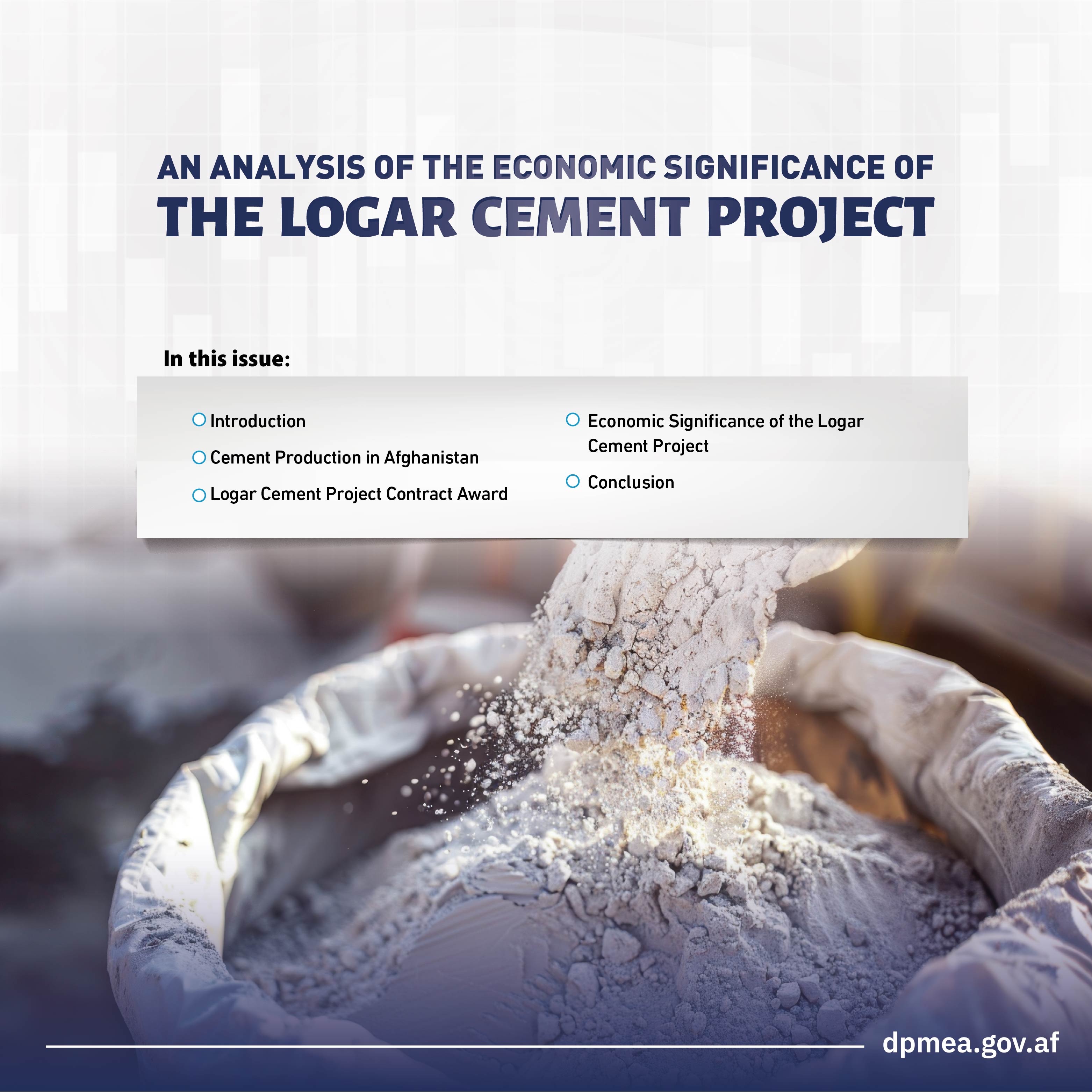An Analysis of the Economic Significance of the Logar Cement Project

Introduction
Cement plays a crucial role in the construction of modern buildings and infrastructure. It is an essential material for building roads, bridges, culverts, houses, and factories.
Globally and nationally, cement significantly contributes to industrial growth and the creation of employment opportunities.
Afghanistan, which has been severely devastated due to decades of occupation and war, has a substantial need for cement for reconstruction activities. Currently, Afghanistan's annual cement demand is approximately seven million tons.
Due to prolonged conflict and occupation, the cement industry in Afghanistan did not experience sufficient growth. Consequently, the country's cement reserves remained untapped. The failure to extract Afghanistan's cement resources has left the country reliant on imports to meet its needs in this sector.
Since coming to power, the Islamic Emirate has paid attention to cement resource extraction alongside other priorities. Efforts are underway to reduce Afghanistan's reliance on other countries by utilizing domestic cement reserves. The awarding of the contract for the Logar Cement Project is part of these ongoing initiatives.
Cement Production in Afghanistan
The first steps in cement production in Afghanistan were taken during the reign of former King Mohammad Zahir Shah. The first cement factory, Ghori (1) in Baghlan, began its operations in the 1950s.
Later, the Jabal al-Siraj Cement Factory in Parwan produced its first cement in 1957. Additionally, the Ghori (2) Cement Factory was also established.
However, with the onset of foreign occupation and war in Afghanistan, the production of these key factories, Ghori (2) and Jabal al-Siraj, was halted, and the country faced a severe shortage of cement production.
These factories played an essential role in meeting Afghanistan's domestic cement needs, but their production was insufficient.
Since the re-establishment of the Islamic Emirate, with improved opportunities for investment and the extraction of domestic resources, the government has attracted both domestic and foreign investments in the cement sector.
Logar Cement Project Contract Award
The Islamic Emirate has taken significant steps toward cement production, meeting domestic needs, and striving for self-reliance. For example, on October 29, 2024, the contract for the construction of the Yatim Taq Cement Factory in Jowzjan was signed with a Turkish company. The contract was valued at 11 billion Afghanis and was signed in the presence of the Deputy PM for Economic Affairs, Mullah Abdul Ghani Baradar Akhund.
Additionally, on December 24, 2024, the contract for the Logar Cement Project was signed with a Chinese company. The company will invest around 145 million USD in exploring and extracting cement in the Logar region. This contract, signed for a period of 30 years between the Minister of Mines and Petroleum and the Head of the Chinese-Afghan company, was also witnessed by Deputy PM Mullah Baradar Akhund.
According to the agreement, the company will first conduct exploration work, followed by the establishment of the factory and the commencement of cement production.
Since the Islamic Emirate’s rise to power, this is the fourth cement-related contract signed. So far, contracts worth approximately 623 million USD have been signed with various companies for cement extraction and production.
Economic Significance of the Logar Cement Project
The Logar Cement Project is a major initiative that will play an important role in Afghanistan's economic development. Below, we will discuss its economic value for the country.
- Reduction of Unemployment:
Unemployment is a significant problem in Afghanistan, and the Islamic Emirate is taking steps to reduce it. The Logar Cement Project will create hundreds of direct and indirect jobs, helping to alleviate unemployment. - Meeting Domestic Cement Demand:
The Logar Cement Project will produce 2,500 tons of cement daily, which will significantly contribute to meeting Afghanistan's internal cement needs. - Reduction of Cement Imports:
Unfortunately, Afghanistan is an importer of cement, and its domestic production does not meet the internal demand. However, projects like the Logar Cement Project will help fulfill this need to some extent, reducing reliance on imports from neighboring countries. - Provision of Services to Local Communities:
Another economic benefit of the Logar Cement Project will be the provision of services to local communities. The company will not only produce cement but will also provide social services to the people. According to the company’s head, efforts will be made for the welfare of the local population. - Attraction of Foreign Investment:
The Logar Cement Project was contracted with a foreign company. The secure and stable environment in Afghanistan, along with the investment from this company, will encourage other foreign companies to invest in the country. - Increase in National Revenues:
The Logar Cement Factory will increase Afghanistan's national revenues, and the money that was previously spent on purchasing cement from neighboring countries will now be spent within the country.
Conclusion
Due to foreign occupation and wars, many of Afghanistan’s underground resources were left untapped. However, with the rise of the Islamic Emirate, security has improved, and a favorable environment for investment has been created. As a result, investment in the cement sector has started.
So far, the Islamic Emirate has signed contracts for four major cement extraction projects across different provinces, with the Logar Cement Project being the latest, signed between the Islamic Emirate and a private company.
With the Logar Cement Project, Afghanistan will not only extract its underground resources but will also stimulate economic growth in the country.